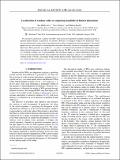Localization of random walks to competing manifolds of distinct dimensions
Author(s)
Levi, Raz Halifa; Kantor, Yacov; Kardar, Mehran
DownloadPhysRevE.98.022108.pdf (1.548Mb)
PUBLISHER_POLICY
Publisher Policy
Article is made available in accordance with the publisher's policy and may be subject to US copyright law. Please refer to the publisher's site for terms of use.
Terms of use
Metadata
Show full item recordAbstract
We consider localization of a random walk (RW) when attracted or repelled by multiple extended manifolds of different dimensionalities. In particular, we consider a RW near a rectangular wedge in two dimensions, where the (zero-dimensional) corner and the (one-dimensional) wall have competing localization properties. This model applies also (as cross section) to an ideal polymer attracted to the surface or edge of a rectangular wedge in three dimensions. More generally, we consider (d−1)- and (d−2)-dimensional manifolds in d-dimensional space, where attractive interactions are (fully or marginally) relevant. The RW can then be in one of four phases where it is localized to neither, one, or both manifolds. The four phases merge at a special multicritical point where (away from the manifolds) the RW spreads diffusively. Extensive numerical analyses on two-dimensional RWs confined inside or outside a rectangular wedge confirm general features expected from a continuum theory, but also exhibit unexpected attributes, such as a reentrant localization to the corner while repelled by it.
Date issued
2018-08Department
Massachusetts Institute of Technology. Department of PhysicsJournal
Physical Review E
Publisher
American Physical Society
Citation
Levi, Raz Halifa et al. "Localization of random walks to competing manifolds of distinct dimensions." Physical Review E 98, 2 (August 2018): 022108 © 2018 American Physical Society
Version: Final published version
ISSN
2470-0045
2470-0053